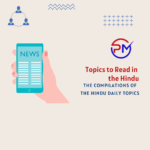1.
- Give an account of the contributions made by Indians to the field of mathematics in ancient and
medieval times. (150 words) 10
Approach:
- Introduce by mentioning about scientific traditions in India.
- Discuss the major contributions made by the Indians to the field of mathematics in ancient and
medieval times. - Conclude accordingly.
Answer:
As one of the oldest civilizations of the world, Indian civilization has a strong tradition of science
and technology, particularly mathematics. Many of the theories of modern day mathematics were
actually not only known to ancient Indians, they also discovered them.
Following are the major contributions made by Indians in ancient and medieval times - Baudhayan (800 BC- 740 BC): It was Baudhayan who first calculated the value of pi. Pi is
useful in calculating the area and circumference of a circle. Pythagoras theorem was
mentioned in Baudhayan’s Sulva Sutra, several years before the age of Pythagoras. - Pingala (around 500 BC): Gave binary numeral system and arithmetical triangle.
- Aryabhata (476-550 CE): He wrote Aryabhattiya, which is a summary of mathematics of his
time. The book includes topics from number theory, geometry, trigonometry and Beejganita
(algebra). Aryabhata showed that zero was not a numeral only but also a symbol and a concept.
Discovery of zero enabled Aryabhata to find out the exact distance between the earth and the
moon. Aryabhata also worked on the approximation of the value of pi. - Brahmagupta (598-670 CE): He introduced negative numbers and operations on zero into
mathematics. He wrote Brahm Sputa Siddhantika through which the Arabs came to know
about Indian mathematical system. - Mahavira (9th Century): He wrote Ganit Sara Sangraha in 850 A.D., which is the first textbook
on arithmetic in present day form. The current method of solving Least Common Multiple (LCM)
of given numbers was also described by him. - Bhaskar Acharya (1114-1185): He introduced Chakrawat Method or the Cyclic Method to
solve algebraic equations. This method was rediscovered six centuries later by European
mathematicians, who called it inverse cycle. His book Siddanta Shirmoni is divided into 4
sections: Lilavati (Arithmetic), Beejaganit (Algebra), Goladhyaya (Sphere) and Grahaganit
(mathematics of planets). - Madhava of Sangamagrama (1340-1350 CE): Discovery of power series expansions of
trigonometric sine, cosine etc. - Jyesthadeva (1530-1610): He gave proof of Pythagoras theorem in his book Yuktibhasa in the
16th Century.
While these contributions were immense, they were not well-documented and disseminated
compared to their counterparts in the modern western world.
2.
- Female poet-saints played a significant role in the bhakti movement. Discuss. (150 words) 10
Approach:
- Introduce by giving a brief background of the Bhakti movement.
- Discuss the significant role played by some prominent female bhakti saints in spreading the
movement. - Conclude appropriately.
Answer:
The Bhakti movement started in the 6th-7th century AD from the Southern part of the country. The
movement grew as a result of the rigid caste system, complicated ritualism that constituted the
practice of worship and the inherent need to move to a more fulfilling method of worship and
salvation. In this context, the bhakti movement advocated for a personal connection to God through
devotion and surrender. This movement also included woman saints who played a significant role
in propagating the idea of Bhakti through their poems, as mentioned below: - Andal: She was an 8th century Tamil Vaishnavite saint and the only woman among the twelve
Alwars. Her work – Thiruppavai – has been included in the sacred Divya Prabandham, the Tamil
Veda. - Akka Mahadevi: She was a 12th century poet-saint of Veer-Saiva sect from Karnataka. She gave
up her societal position and domestic security for the company of Shiva. Through her ‘vachanas’
she fought to prove that every soul, irrespective of gender, has a right to explore and reach the
divine. - Lal Ded or Lalleshwari: She was a 14th century mystic of the Kashmiri Shaivite sect. The
dominant theme of her poems called the ‘vakhs’ was the rejection of rituals in favour of
meditative devotion, questioning the secondary status of women and advocating equality for all. - Janabai: She was a 14th century Marathi religious poet and devotee of Lord Vitthoba. Her
‘Abhangas’ are included in collections of the work of the bhakti saint Namdev. She gave a
message that despite being a woman, one can achieve the love of God. - Meerabai: She was a 16th century traveling-saint and devotee of Lord Krishna from Mewar
region. Her ‘bhajans’ show intense devotion towards Krishna and her defiance of patriarchal
norms associated with powerful institutions of family, marriage, caste, clan, royalty, etc. of that
time. Even Gandhiji considered Meerabai as an exemplar of non-violent resistance. - Bahinabai: She was a poet-saint from 17th century Maharashtra and devotee of Lord Vitthoba.
Despite her high caste status, she defied all conventions and chose the path of devotion of the
low-caste poet-saint Tukaram. Abhangas written by her shows that unlike other female bhaktisaints
who renounced their married life for God, Bahinabai chose a middle path and questioned
patriarchy and the caste system without upsetting them as a whole.
The contribution of the female poet-saints to the bhakti movement has been immense. Their
writings not only mention the social conditions of the times but also depict their devotional fervour
and metaphysical depth.

